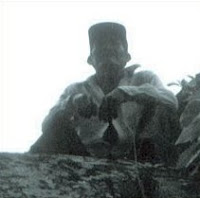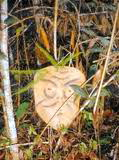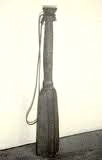I had promised myself that I would not talk about canaima.
Now, I have been a lot of places in my time, and I have seen some very weird things. But there are really only two things that I find truly creepy — tsantsa, shrunken human heads, and canaima. And that is because, I suppose, both tsantsa and canaima are supposed to be creepy. That is their purpose — to create horror and fear.
Indeed, it was the investigation of canaima by Neil Whitehead, a University of Wisconsin-Madison professor of anthropology, that initiated the current interest in what has been called dark shamanism, and especially the view of assault sorcery as, in some sense, socially integrating, and as a vehicle of resistance to political and colonial oppression.
Among many indigenous peoples of the Guyana Amazon, the term canaima refers both to a mode of ritual killing and to its practitioners, a form of dark shamanism involving the mutilation and lingering death of its victim, who becomes, after death, the shaman’s food. The soul of the shaman may travel invisibly to injure or kill the victim, or it may be transferred into the body of a jaguar, snake, sting ray, or some other animal in order to attack. Victims may be chosen simply because they are vulnerable — weak, or old, or traveling alone; in other accounts, the canaima shaman may attack out of vengeance or resentment, like other Amazonian sorcerers.
Canaimas may announce their intention to attack with bird-like warning calls. In nonfatal attacks, the victim may have bones broken, especially fingers and ribs, as well as joints dislocated or cut, especially in the shoulder, or receive painful spinal injuries. Then, months or years after the first attack, the canaima returns to mutilate and kill the victim.
 |
| Pirai, a self-professed canaima |
In these fatal attacks, intended to produce ritual food, the victim is struck from behind with a special club and the tongue pierced with the fang of a venomous snake, so the victim cannot speak. An iguana or armadillo tail is inserted into the rectum and the anal muscles stripped out. The anal sphincter is forced out by pressing on the stomach and severed. A thin flexed twig is inserted into the rectum, so that it opens the anal tract, into which are inserted packets of herbs, beginning a process of autolysis by which the body begins to dissolve.
After a time the victim awakens and goes home, where fever and aching joints soon develop, followed speedily by death. Since the victim cannot or will not talk, friends and relatives are unable to obtain information which would enable them to seek out the canaimas. The work of the canaimas can, however, usually be recognized by the blue finger marks on the body of the victim — bruises left by the canaimas during the attack. As the victim is unable to speak, eat, or drink, and bowel control is lost, the cause of death, for medical certification procedures, is given as “acute dehydration through diarrhea.”
Three days after death, the shaman inserts a hollow stick into the rotting, buried body — decaying human remains smell sweet to a canaima — and sucks out the the putrid liquid, which makes the sorcerer invulnerable to revenge by the victim’s family. And there is another reason as well. After killing, the shaman becomes hot — so hot that he will do anything to cool down. He will send his spirit into an animal, or especially will suck the cooling juice of the corpse in the ground through a hollow tube, or, some say, send his spirit into the ground to eat and drink the corpse. He will go into the water and suck an anaconda, to dissipate the heat of his fury.
 |
| Canaima mask |
In order to protect the victim’s corpse, family members will bury it with poison, or in a secret place, or with the liver removed and replaced with a red-hot axe-head, so that the heat of the axe will pass into the body of the canaima and kill him. People suspected of being canaimas may be beaten to death with a special club.
Whitehead places both the belief and the practice at the beginning of the nineteenth century, “as a defensive magico-military technique to ward off the new and overwhelming gun violence and slave trading” — a form of dialogue with and about colonizing modernity that continues to serve a variety of cultural purposes, similar to the yagé shamanism of the Putumayo analyzed in similar terms by anthropologist Michael Taussig.
But the killing of the helpless victim has cosmological symbolism as well. The canaima is the shaman of Makunaima, who is the creator of all animals and plants. In return for his bounty to humans, and in order to ensure his continuing benevolence, the shaman makes a human sacrifice — the victim is food for lord jaguar and the garden spirit. Thus the killing creates life; the dark shaman contributes to the ongoing cycles of fertility and death without which humans could not live. “It represents the sorcerer’s gift to divine beings,” Whitehead says in an interview. “The purpose is to sustain plants, fish, and animals.”
 |
| A special club used for killing canaimas |
Are there really canaimas out there? Whitehead claims to have met them, or at least met people who claimed to be canaimas, and who apparently offered to teach him how to be a canaima himself, in exchange for money. One of them told him, “We come invisible, fast…. We searching for our food is all, that is all it is. We look at someone and see something sweet to suck … We can kill anyone — blacks, whites, anyone — stop them up good. This is what I will tell you of the high-science.”
Another anthropologist, Audrey Butt Colson, sees canaima instead as a category of accusation — that is, something that is not practiced, but rather something of which people are accused. Whitehead sees canaima as a method of ritual assassination; Butt Colson sees it as magical, invisible, symbolic, analogous in social function to sorcery elsewhere in the Amazon.
Whitehead does not entirely disagree. Canaima “is actually not exceptional,” he says. “It’s one example of a very important aspect of shamanism in South America. There’s been an emphasis on the curing, beneficial aspects of shamanism. We want to set the ethnographic record straight by reminding people of the very important cosmological links between the power to kill and the power to cure. They represent complementary possibilities of the universe, and are fundamental to the way shamanic activity is conceived.”
Part of the basis for Whitehead’s belief in the reality of canaima is the testimony of a medically trained nurse who claims to have treated its victims. Fortunately, the video of this interview is available:

- Previous Post: Buryat Shamanism Exhibit
- Next Post: Magic
- More Articles Related to: Indigenous Culture, Shamanism, The Amazon


